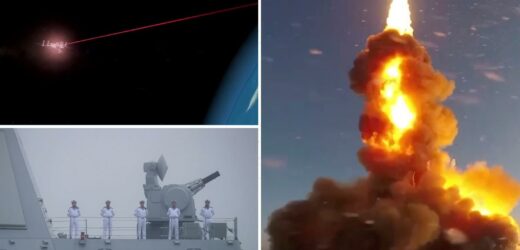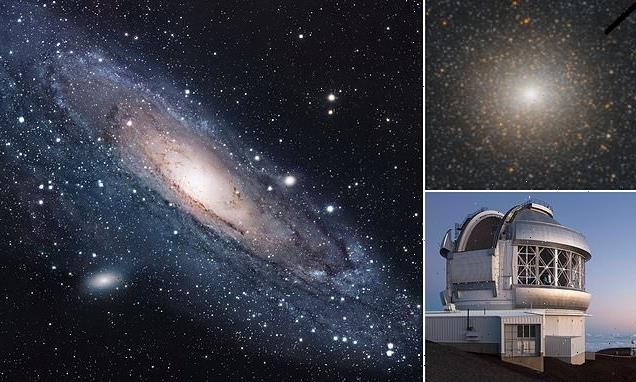CHINA and Russia are posing a "daily threat" to the world from space with lasers and missiles ready to blast satellites out of the sky, a military chief has warned.
Air Chief Marshal Sir Mike Wigston said Moscow and Beijing are engaging in "dangerous activity" – such as flying satellites within "close proximity" of others – on a daily basis.
He warned future wars would be "won or lost in space" and said the UK are gathering intelligence on the "questionable" activity, The Telegraph reports.
Sir Mike said "reckless" behaviour from the two nations was seen "several times a year".
He said Russia has deployed satellites that "we would describe as having the characteristic of a weapon and they practised a manoeuvre, that we would say, could only have been done to deliberately destroy another satellite".
And China has continued to "develop anti-satellite technology, and that’s everything from missiles that directly target satellites, to laser dazzle weapons, to electronic jamming to physically ramming other satellites".
China has tested out the dangerous stunts against "their own redundant satellites" and proved successful, Sir Mike told The Telegraph.
Satellites provide communications, navigation, and intelligence to any nation's war machine, so knocking them out would seriously disrupt – and even render useless – much of its equipment.
Sir Mike warned: "A future conflict may not start in space, but I’m in no doubt that it will come very quickly to space, and it may well be won or lost in space.
"If we don’t think, and prepare for that today, then we won’t be ready when the time comes."
CHINA'S GIANT LASER WEAPONS
China has been working on laser weapons since the 1960s, according to a 2017 report.
The International Assessment and Strategy Center suggested China could even have a space-based laser within a decade.
Experts have warned about China's giant laser weapons that could cripple American satellites and blind the US fleet in the event of a war.
Multiple Pentagon and intelligence reports warned about the potential of these weapons, and according to some sources, they are already here.
Back in 2019, Amazon’s Prime’s "China vs USA: Empires at War" series said an existing weapons system could knock out American warships navigation systems and communications, leaving them practically useless.
The series revealed: "The Chinese army has developed a system to blind the Americans. This is not science fiction, but a technology already in use."
A Pentagon report, cited by Global News, appeared to cement the fears.
The news outlet said the US Department of Defense warned the development of anti-satellite laser weapons by China and Russia was one of the key drivers for Trump’s new Space Force.
The report said: "China and Russia, our strategic competitors, are explicitly pursuing space war-fighting capabilities to neutralize US space capabilities during a time of conflict."
A future conflict may not start in space, but I’m in no doubt that it will come very quickly to space, and it may well be won or lost in space.
The report said both countries were developing energy weapons technologies to disable satellites, citing national intelligence director Dan Coats’ May 2017 worldwide threat assessment statement.
Wan Xiangsui, a military strategist for the People's Liberation Army, told the Express: "The US relies on satellites to control their entire communications network and that is a weakness.
"This dependence reminds me of the Greek legend Achilles who was invulnerable, except his heel. And satellites will be America’s Achilles heel."
And back in April, China unveiled their new deadly destroyer warship that can shoot down ballistic nuke missiles and satellites.
It's the world's second-most powerful destroyer, behind the US Navy's Zumwalt-class.
At around 180 metres long and 22 metres wide, the Type 055 has 112 vertical launch missile cells, which can launch a combination of surface-to-air missiles, anti-ship missiles, land-attack missiles and anti-submarine missiles.
This means it can deploy projectiles to intercept incoming attacks, thanks to its dual-band radar system.
Rigged out with a helicopter deck and a stern hangar, capable of accommodating up to two helicopters, it enables China to prepare for attacks from every angle.
RUSSIA TARGETS SATELLITES
Meanwhile, test footage has revealed Russia's terrifying new S-500 Prometheus system which it claims can destroy incoming hypersonic missiles in near-space.
The video was released earlier this month as the Kremlin warned the US it could spark World War Three by basing its new-generation nukes in Europe.
The S-500 surface-to-air defence system is designed to bring down enemy aircraft and missiles up to an altitude of 125 miles.
It brings ballistic missiles and potentially even low orbit satellites within range.
The new 77N6-N missile can reportedly hit a target travelling at over 11,000mph – or three miles a second – while being guided by an advanced radar tracking system in a second vehicle on the ground.
Major General Babakov, commander of Russian missile defence troops, boasted: "The S-500 air defence system is capable of destroying hypersonic weapons of all modifications, including in near-space, in addition to aerodynamic and ballistic targets, which makes it possible to say with confidence that this system is unique."
And last year, Russia tested a terrifying new 9,000mph "star wars" ballistic missile capable of destroying US satellites in space.
Most read in News
MAJOR SHOCK New evidence about chief Maddie suspect leaves investigators 'shocked'
Runaway bus packed with kids nearly hits woman before 'brake fail' crash
PM insists he hasn't broken law but vows to 'fully cooperate' with Met probe
Pupil joked about sex with my teacher boyfriend – then I found naked pics
The rocket was launched from the Sary-Shagan test site in Kazakhstan and wiped out a dummy target, according to the Kremlin.
Footage released by Putin's Defence Ministry showed the weapon – “designed to protect against air and space attacks” – taking off in a ball of flames.
At the time, Commander of the United States Space Command John Raymond said Russia's extraterrestrial interceptor missiles pose a challenge to US interests in space.
Source: Read Full Article










